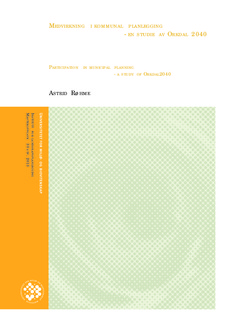Medvirkning i kommunal planlegging : en studie av Orkdal 2040
Master thesis
Permanent lenke
http://hdl.handle.net/11250/188580Utgivelsesdato
2013-09-18Metadata
Vis full innførselSamlinger
- Master's theses (ILP) [763]
Sammendrag
Medvirkning i kommunal planlegging er lovpålagt gjennom Plan- og bygningsloven av 8.mai 2009.
Loven angir minimumskravene for medvirkning, samtidig som det oppfordres til «aktiv medvirkning»
(pbl §5-1). Like før iverksetting av den nye plan- og bygningsloven igangsatte Orkdal kommune et
større planarbeid «Orkdal 2040», som ble utarbeidet etter den nye lovens bestemmelser. På grunn
av økt befolkningsvekst og knapphet på areal, ønsket man et styringsverktøy for den videre
sentrumsutvikling. Prosjektet ble initiert av administrasjonen i Orkdal kommune og Fylkesmannen i
Sør-Trøndelag. Prosjektet skulle munne ut i en kommunedelplan for tettstedene Orkanger, Fannrem
og Gjølme som skulle legge føringer fram mot 2040. Prosjektet hadde god økonomi noe som gav et
stort handlingsrom. Målsettingen var ambisiøs, prosjektet skulle sette standarden for
brukermedvirkning i statlig, regional og kommunal planlegging og bli «Norges beste planprosess».
Orkdal 2040 var en prosess hvor det ble tatt i bruk utvidede former for medvirkning. Det er
interessant å se nærmere på erfaringene knyttet til praksis der utvidede former for medvirkning ble
tatt i bruk. I prosessen ble det satset høyt på medvirkning og det ble tatt i bruk mange tradisjonelle
tiltak i tillegg til nyskapende tiltak som egen nettside og SimOrkdal, et visualiseringsverktøy på nettet.
Hvordan de ulike medvirkningstiltakene ble brukt og vurdert av lokalsamfunnet er studert gjennom
spørreundersøkelse, intervju og dokumentanalyse. Hensikten er å belyse hvordan
medvirkningsprosessen ble ivaretatt i et spesifikt planarbeid. Undersøkelsen viser at de tiltakene
som ble brukt og vurdert som et godt verktøy var de tradisjonelle virkemidlene som folkemøte, bruk
av mediene, innspill og høring. Satsningen SimOrkdal som skulle bidra til å bedre brukermedvirkning
ble i liten grad brukt. Målet og de tilrettelagte virkemidlene var mer omfattende og inkluderende enn
i en vanlig kommuneplanprosess. Fokuset på medvirkning skapte høye forventninger i
lokalsamfunnet, og de iverksatte tiltakene nådde til tider ikke opp til disse forventningene. Dette
førte blant annet til lokale initiativ og engasjement i tillegg til prosjektets opplegg for medvirkning.
Undersøkelsens viser at politikerne (100%) var veldig fornøyde med prosessen, mens
velforeninger/grendelag som var like engasjerte og aktive er lite fornøyd (16%). Dette kan tyde på at
hvor fornøyd man er med prosessen, avhenger av hvilken rolle man hadde og til en viss grad
forventningene til planlegging. Rammene for medvirkning var noe uklare. I Orkdal 2040 ble det lagt
opp til bred medvirkning uten noen form for avgrensning, mens prosessen skulle munne ut i en
kommunedelplan som har klare rammer. Å avklare hvilke rammer som gjelder og legge noen føringer
på hva som kan påvirkes er viktig når man inviterer til deltakelse.
Intensjonene var gode, målene høye, men resultatene sto ikke til forventningene. Participation in municipal planning is mandated through the Planning and Building Act of May 8,
2009. The law sets the minimum requirements for participation, while it encourages to "active
participation" (PBA § 5-1). Just before the introduction of the new Planning and Building Act Orkdal
initiated a larger planning named "Orkdal 2040", which was elaborated according to the new law.
The project was lanced due to increased population growth and scarcity of land, and they desired a
management tool for the further development of the city-center. The project was initiated by the
administration in Orkdal Municipality and the County Governor of the region Sør-Trøndelag. The
project should result in a part-strategic municipal plan for the urbanisation of Orkanger, Fannrem
and Gjølme that would set some guidelines up to 2040. The project had good economy which
enhanced good opportunities. The goal was ambitious and the project was meant to set the standard
for user participation both in state, regional and municipal planning and therefore be "Norway's best
planning process."
Orkdal 2040 was a process where extended forms of participation were introduced. It is interesting
to look at the experiences related to the practice of the different participation methods that were
used. In the process which focused on a high grade of participation they used many traditional
methods as well as more innovative methods such as the Municipality’s own website and SimOrkdal,
a modern online visualization tool. To study which methods were most efficient for participating in
the project the Municipality made surveys, interviews and document-analysis for evaluation. The
purpose was to illustrate how the participation process was maintained in this specific planning
according to the aim of being “Norway’s best planning process”. The study shows that the traditional
methods such as open meetings, using the media, consulting the people and letting them give input
were most successful. The focus on SimOrkdal that should facilitate the participation for the user was
not significantly used.
The goal and the adapted tools were more extensive and inclusive than in an ordinary municipal
planning process. The focus on high participation of the community created big expectations in the
local community groups and associations, and the measures to reach these expectations did not
always satisfy this aim which led to a local initiative and commitment in addition to and parallel to
the real project's initially call for contribution.
The study shows that the politicians (100%) were very satisfied with the process, while associations /
community groups who were equally committed and active were not satisfied (16%). This suggests
that how satisfied you are with the process depends on which role one has and to some extent the
expectations. The framework for the participation was somewhat unclear. Orkdal 2040 initiated a wide participation without any delimitation whereas the process should culminate in a part-strategic
municipal plan that already had certain definitions. Defining the restrictions of the project as well as
preparing the participants on what parts of the plan their influence can have an impact is important
when one invites for participation.
The intentions were good, the goals high however the results did not meet the expectations.
